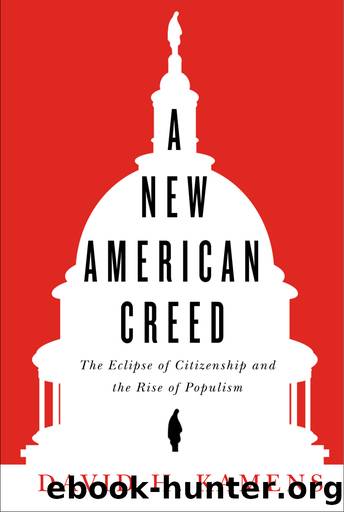A New American Creed by Kamens David H.;

Author:Kamens, David H.; [Kamens, David H.]
Language: eng
Format: epub
Publisher: Stanford University Press
Published: 2019-08-14T16:00:00+00:00
TABLE 8.2 State Funding of Four-Year Public Universities
Source: Michael Leacham, Vincent Palacies and Michael Mitchell, States Are Still Funding Higher Education at Below Pre-Recession Levels Report, Center on Budget and Policy Priorities, Washington, D.C. May 1, 2014.
*Source Table 41: Mobile Digest of Educational Statistics, 2013, National Center for Educational Statistics, Washington, D.C.
University leaders have had to scramble to replace the cuts in state funding. Consequently, tuition has become much more significant in their budgets (see Table 8.3). As a result, average tuition at state universities and colleges has nearly doubled over this period, while tuition at private institutions has grown as well. This change has magnified the gap between wealthy private institutions, where corporate funding and individual philanthropy are significant, and public universities that are losing state funding. The difference between an elite sector and the rest of higher education is growing.
Over the longer haul from 1973 to 2014, tuition has more than tripled in inflation-adjusted dollars, while median family income increased by 5 percent (Center on Budget and Policy Priorities, 2014).9
Federal legislative change in the late 1970s made the substitution of tuition for public funds possible (Geiger, 2009). Before this time there were strict legal limits on how much students or their families could borrow to pay for college. Private banks made the loans, and the government guaranteed them. The reasoning for limits on borrowing was simple. Keeping loans small helped guarantee that students would repay them. Tuition rates were lower then, so this logic made sense.
However, as the defunding of higher education intensified, colleges and states were eager to find substitutes for the decline in public funding. Congress obliged and took the limits off the amounts that students could borrow in 1978 (see Geiger, 2009). Students, private banks, and the federal government are now substantially funding both public and private universities via these loans.
Download
This site does not store any files on its server. We only index and link to content provided by other sites. Please contact the content providers to delete copyright contents if any and email us, we'll remove relevant links or contents immediately.
| Anarchism | Communism & Socialism |
| Conservatism & Liberalism | Democracy |
| Fascism | Libertarianism |
| Nationalism | Radicalism |
| Utopian |
The Secret History by Donna Tartt(16622)
The Social Justice Warrior Handbook by Lisa De Pasquale(11489)
Thirteen Reasons Why by Jay Asher(7788)
This Is How You Lose Her by Junot Diaz(5770)
Weapons of Math Destruction by Cathy O'Neil(5036)
Zero to One by Peter Thiel(4824)
The Myth of the Strong Leader by Archie Brown(4789)
Promise Me, Dad by Joe Biden(4447)
Beartown by Fredrik Backman(4415)
Stone's Rules by Roger Stone(4415)
How Democracies Die by Steven Levitsky & Daniel Ziblatt(4398)
The Fire Next Time by James Baldwin(4342)
100 Deadly Skills by Clint Emerson(4076)
A Higher Loyalty: Truth, Lies, and Leadership by James Comey(4032)
Rise and Kill First by Ronen Bergman(4012)
The David Icke Guide to the Global Conspiracy (and how to end it) by David Icke(3881)
The Farm by Tom Rob Smith(3872)
Secrecy World by Jake Bernstein(3782)
The Doomsday Machine by Daniel Ellsberg(3730)
